If you are planning to travel to China with limited budget, please do not miss the 16-day China Dreamland Budget Tour. As a cost-effective travel plan, we are devoted to providing better service by less spending. Accompanied by our experienced guide, you will have a lot of places to visit, including Beijing, Kunming, Jianshui, Yuanyang, Dali, Lijiang, Shangri-La and Shanghai. As you see, most places we mentioned belong to Yunnan Province, a dreamland where you can enjoy pastoral scenes and they will certainly feast your eyes. During cheap Yunnan tour, you can visit Stone Forest in Kunming, Zhu Family Garden in Jianshui, Yuanyang Rice Terrace in Yuanyang, Blue Moon Valley in Lijiang, and Tiger Leaping Gorge in Shangri-La, etc. During cheap Dali tour, you will enjoy the architectural beauty of Three Pagodas of Chongsheng Temple without buying tickets. During Shanghai tour, we will visit Oriental Pearl TV Tower with less spending compared with ascending other skyscrapers to enjoy the same beautiful scenery. Join us on this tour and make the most out of your expenses!

Welcome to Beijing! Your wonderful 16-day China dreamland budget tour will start here. On this tour, you will enjoy nice service with less spending.
Beijing, the capital of China, is a prosperous international metropolis as well as China’s center of politics, culture, international exchange, as well as science and technology innovation. Covering an area of about 16,410 square kilometers, Beijing now has a population of more than 21 million.
Upon arrival, your local guide will pick you up at the arrival hall and then transfer you to your hotel. Have a good rest. Your unforgettable 15-day China tour is approaching!
Today, your 15-day China tour begins. After breakfast, you will visit Tian’anmen Square. Located in the center of Beijing, Tian’anmen Square occupies an area of 440,000 square meters, with 880 meters in length from north to south and 500 meters in width from east to west. It can accommodate 1 million people for grand gatherings. The National Flagpole, Monument to People’s Heroes, the Chairman Mao Memorial Hall, and the Zhengyangmen Gate Tower stand in the square, along the central axis of Beijing from north to south. Monument to the People’s Heroes is certainly worth seeing. It was built in 1958, and the construction lasted for about 9 years. Monument to the People’s Heroes is with a height of 37.94 meters, and the front (facing north) of the monument is a large piece of granite, and is engraved with eight golden characters inscribed by Chairman Mao on June 9, 1955. The back of the monument is a 150-word inscription, drafted by Chairman Mao and inscribed by Premier Zhou to commemorate people’s heroes in the process of obtaining national independence and people’s liberation.
After walking through Tian’anmen Square, you will come to the Forbidden City (closed each Monday). The Forbidden City is one of the largest and best-preserved ancient wooden-structure palace complexes in the world. It was listed as a World Cultural Heritage in 1987. The Forbidden City acted as an imperial palace of the 24 emperors in the Ming (1368-1644) and Qing (1636-1912) Dynasties in China. The Forbidden City is about 961 meters long from north to south and 753 meters wide from east to west. It covers an area of about 720,000 square meters, with a construction area of about 150,000 square meters. The Forbidden City is surrounded by a 10-meter high wall and a 52-meter moat outside the wall. The moat was built in 1420 in the Ming Dynasty and its total length is about 40.7 kilometers. During the Ming and Qing Dynasties, the moat mainly supplied water for palaces and protected the Forbidden City. It was an important part of the capital water system. Several sluices and dams were built on the moat to regulate the water flow and control the flow rate.
After walking through the Forbidden City and going northward, you will visit Jingshan Park. Jingshan Park was a royal garden in the Ming and Qing Dynasties. It was built in 1928, covering an area of 23 hectares including 1,100 square meters of flowers and lawns. The park is represented by Jingshan Mountain, with lush pines, cypresses, and peonies imported from all over the country.
In the afternoon, you will go to the Temple of Heaven for sightseeing. Temple of Heaven is a place where ancient emperors worshipped the god of heaven and prayed for a good harvest in the Ming and Qing Dynasties. Built in 1420, it covers an area of about 2,730,000 square meters. As the largest existing temple complex in China, it was listed as a World Cultural Heritage in 1998. Temple of Heaven attracts lots of tourists from home and abroad every year. One of the most interesting sites in the Temple of Heaven is the Seven-Star Stones. Seven-Star Stones are seven boulders arranged according to the direction of the Big Dipper. Actually, there are eight stones in total, but why do we call it Seven-Star Stones? It is said that the emperor Zhu Di in the Ming Dynasty, usurping the throne, wanted to find an auspicious place to worship heaven. One night, he dreamed that the gate of heaven was opened wide and the Big Dipper fell to the place where the Temple of Heaven is located. He thought that this meant the place was auspicious and then he ordered craftsmen to build the Temple of Heaven, as well as placing seven stones inside, which symbolized the Big Dipper. That was the origin of the Seven-Star Stones. The eighth stone was added in the Qing Dynasty by Emperor Qianlong. He believed that the seven stones represent the seven giant mountains in central and southern China, and wanted to add the Changbai Mountain in his hometown in northern China. So he ordered to place another stone in the northeast of the existing Seven-Star Stones. Therefore, the Seven-Star Stones is what you see now.
Then we will drive northwest for about 40 minutes to visit the Summer Palace, 23 kilometers away from the Temple of Heaven. The Summer Palace, formerly known as the Qingyi Garden, was a royal garden in the Qing Dynasty. It is the best-preserved and most beautiful imperial garden in existence in China, so it is praised as the Royal Garden Museum. Built in 1764, the Summer Palace was the most important center of political and diplomatic activities for the supreme rulers of the late Qing Dynasty except for the Forbidden City.
Optional Activity:
Red Theatre is a good place for you to know about Chinese Kungfu. You can watch an exciting Kungfu show called Legend of Kungfu, performed from 19:30 to 20:50. Actors are all Chinese martial artists. During the show, they will perform different kinds of Chinese Kungfu, such as tiger style boxing, snake style boxing, single-whip skill, and double-whip skill. Legend of Kungfu is one of the most popular shows in the Red Theatre and has made Red Theatre a new highlight of tourism in Beijing.
Peking Roast Duck is a well-known delicacy. With a history of about 1,500 years, Peking Roast Duck used to be a royal dish in ancient China. Later, it became a regular dish among commoners. The local chef will slice Peking Roast Duck into more than one hundred pieces with both meat and skin beside your table and offer thin pancakes as well as condiments, such as onions, sweetish sauce, and sugar. Our local guide will teach you how to eat Peking Roast Duck in an authentic way.
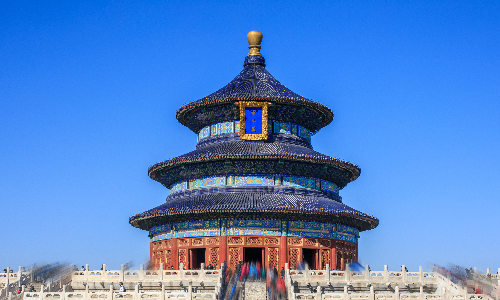
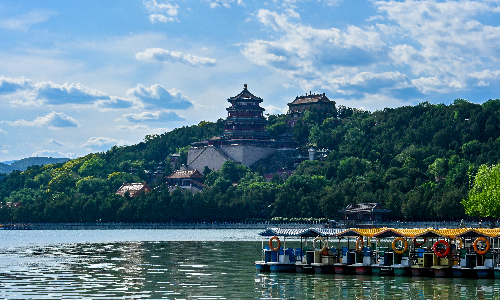
After breakfast, we will drive northwest for about an hour to come to Ming Tombs, 45 kilometers away from the Summer Palace. Ming Tombs is where 13 emperors and 23 empresses in the Ming Dynasty were buried. Covering an area of over 40 square kilometers, it is the largest imperial mausoleum complex with the largest number of emperors and empresses buried in China, even in the world. Today we will take a look at the Ding Tomb, the only one that has been excavated among the thirteen tombs. It is the tomb of Emperor Zhu Yijun, the 13th emperor in the Ming Dynasty, and his two empresses. The construction lasted from 1584 to 1590. In 1956, an archaeological team started to excavate the Ding Tomb. It took the team about one year to find the Diamond Wall, the protective wall of the underground palace. The team members moved the wall and dug forward. Then they discovered countless silverware, jade ware, and other antiques, as well as fancy brocades. What surprised the team members was that the dead emperor lied on his side rather than on his back. His legs were slightly bent, presenting a form like the Big Dipper. As for why he lied like this remains a mystery till today.
In the afternoon, we will drive northeast for about an hour to our next stop, Mutianyu Great Wall, 41 kilometers away from the Ding Tomb. The Great Wall is a marvelous defensive project built by Emperor Qin Shihuang, the first emperor of the Qin (221-207BC) Dynasty. Mutianyu Great Wall is the best-preserved and longest section in the Great Wall. Its forest coverage rate is over 96% that all the other sections in the Great Wall can not be compared with. Graffiti on the wall is prohibited in all sections of the Great Wall, yet Mutianyu Great Wall has a graffiti zone for tourists, where you can write down your mood, travel experience, and so on. Besides, Mutianyu Great Wall provides the most types of transportation facilities for you to choose from. There are cable cars, chairlifts, and toboggans that you can take.
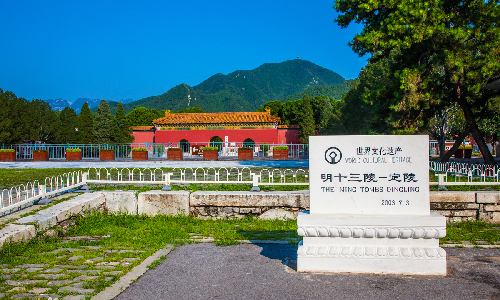
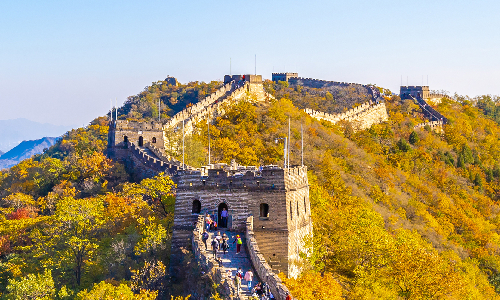
 Kunming
Kunming After breakfast, you will be sent to the airport. Then you will take the estimated flight CZ8941 13:30/16:55 to Kunming. Kunming, the provincial capital of Yunnan Province, is a beautiful city with lots of natural attractions. Covering a total area of about 21,012 square kilometers, it now has a population of more than 8.46 million. Kunming has spring-like four seasons, and is known as “spring city”. Due to its nice climate and natural landscape, Kunming is one of the most popular tourist cities in China. Besides, as a multiethnic city, its unique folk customs also attract more and more tourists from home and abroad. Kunming is certainly worthy of visiting!
Upon arrival, your local guide will be waiting for you and then send you to your comfortable hotel to have a good rest.
 Jianshui
Jianshui After breakfast, we will drive southeast for about an hour and twenty minutes to visit Stone Forest, 85 kilometers away from Kunming. Stone Forest is a natural attraction and it has been rated as “World Geopark” by UNESCO. Ashima is one of the most famous spots in the Stone Forest, which looks like a girl. It is said that this is the stone that Ashima (a local girl) turned into. Legend has it that a beautiful girl named Ashima and a brave boy named Ahei fell in love with each other and are ready to get married, but a rich man forced Ashima to marry him instead of Ahei. Although given gold, silver, and other treasure, Ashima refused to marry him. But the rich man didn’t give up and challenged her fiance Ahei to a series of competitions. He promised that he would give up on her if he lost. Brave Ahei won the competitions in the end, but the rich man broke his promise. He colluded with a water spirit to drown the couple in the river. The couple were separated by a whirlpool in the river. When Ahei struggled to go ashore, he couldn’t find Ashima. Ashima was unfortunately sucked into the whirlpool and died. A goddess felt compassionate about the couple and turned the body of Ashima into a stone so that Ahei can come and visit her from time to time.
Then we will drive southward for around two hours and forty minutes to come to Jianshui, 208 kilometers away from Stone Forest. Jianshui is a multiethnic county where ethnic groups such as Hani, Yi, and Dai live. It is a well-known historical and cultural county, as well as one of the most popular tourist counties in China. Covering an area of 3,789 square kilometers, Jianshui has a population of around 550,000.
In the afternoon, we will go to Zhu Family Garden for sightseeing. Zhu Family Garden was built by a squire named Zhu Weiqing in the late Qing Dynasty. Occupying an area of more than 20,000 square meters, it has 42 courtyards and 214 rooms. Zhu Family Garden is a precious architectural, historical and cultural heritage in Jianshui. It is a product of the architectural art of Han nationality and local ethnic minority. There are bamboos, trees, and fishponds decorated with lotuses, as well as rice fields in the garden. After visiting, you will be sent to your hotel in Jianshui for a good rest.
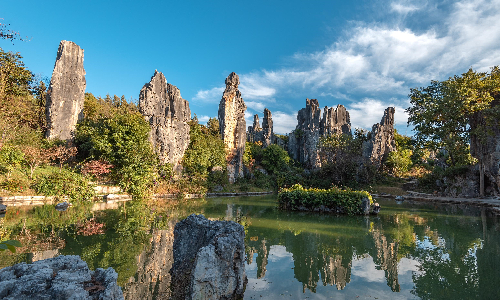
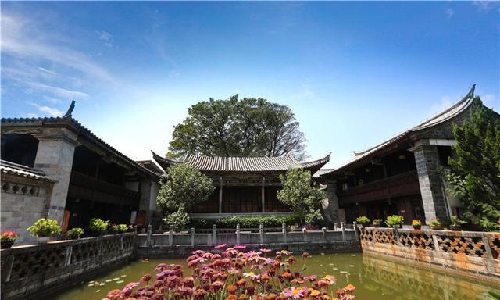
 Yuanyang
Yuanyang After breakfast, we will drive southward for about two hours and fifteen minutes to our next destination, Yuanyang, 81 kilometers away from Jianshui. Located in southern Yunnan Province, Yuanyang occupies an area of over 2,212 square kilometers. It has a population of more than 424,284. Due to its warm climate and abundant rainfall, Yuanyang County is one of the important places of origin of tropical fruits in China. Yuanyang is famous for Yuanyang Rice Terrace. There are three major terraces, including Bada Rice Terrace, Duoyishu Rice Terrace, and Laoyingzui Rice Terrace. Bada Rice Terrace is the one we will take you to today. Bada Rice Terrace is a large-scale terrace for it has 3,000 steps with field ridges as the unit of calculation. Standing on the Bada observation deck, you can see about 933 hectares of terraces, which will definitely feast your eyes.
In the afternoon, you will visit Jingkou Folk Customs Village. The village has distinctive ethnic characteristics of Hani nationality. It retains relatively intact traditional buildings and folk customs as well as a culture without too much external cultural interference. Around the village, there are large stretches of terraces, which is very spectacular. And the villagers are very hospitable to tourists!


After breakfast, you will visit Duoyishu Rice Terrace. Duoyishu Rice Terrace is a good place to view the sea of clouds and sunrise. It is a paradise for photography enthusiasts to shoot the sunrise. Covering an area of more than 6 million square meters, it is one of the core protection zones in China. Yunnan Story, a documentary, was filmed here, based on the local terrace and the villages.
Then you will come to Aichun Village for sightseeing. Aichun Village is a village populated by Hani nationality. Aichun Village is renowned for its blue terraces. The “blue” in its name doesn’t refer to the actual color of the rice terraces here. It is related to the blue sky that the water in the terraces reflects. Entering the village, you may see the villagers wearing their ethnic costumes. Mushroom-shaped houses are their special buildings, some of which are grass-roofed. The villagers are hospitable to visitors. If you are interested, you can ask them about their ethnic stories.
In the afternoon, you are going to take a look at Azheke Village. Azheke Village is also a village populated by Hani nationality. Azheke is “a small place of auspiciousness” according to its literal meaning. Mushroom-shaped houses can also be seen in Azheke Village. Entering the village, you can see guest houses, shops, and restaurants busy welcoming guests from around the world.
Then you will visit Laoyingzui Rice Terrace. Covering an area of more than 400 hectares of terraces, Laoyingzui Rice Terrace is one of the most popular rice terraces in Yuanyang. It was listed by a French magazine as one of the seven most beautiful cultural landscapes in the world in 1993, and was praised as the most magnificent rural scenery by a famous American photographer. In March 1993, Mr. Yang, a famous director in France, came here with his fiancee. He held his wedding in Laoyingzui Rice Terrace, and also shot his film Sculptor of the Mountains here. When the film was on, the rice terrace here became famous in the world. Then your guide will take you back to your hotel for a nice rest.


 Kunming
Kunming Dali
Dali Today we will drive northward for about 5 hours to go to Kunming railway station, about 372 kilometers away from Yuanyang. Then you will take the estimated train D8714 16:00/18:01 to Dali. Situated in western Yunnan Province, Dali is a well-known historical and cultural city. Covering an area of 1,468 square kilometers, Dali has a population of more than 610,000. It is inhabited by many ethnic minorities, mainly Bai nationality, accounting for 65% of the total population. Dali boasts several attractions such as Erhai Lake, Three Pagodas of Chongsheng Temple, and Dali Ancient Town.
Upon arrival, your local guide will be waiting for you in the station and then send you to your comfortable hotel in Dali to have a good rest.
After breakfast, you will go to Erhai Lake for sightseeing. As the second-largest freshwater lake in Yunnan Province, Erhai Lake covers an area of 256.5 square kilometers. It is about 42.58 kilometers long and 9 kilometers wide. It is not only a tourist attraction but also a place with rich aquatic resources like carps, herrings, shrimps, and crabs. You can enjoy the lucid lake and take some nice photos here. A story about Cangshan Mountain (the mountain by Erhai Lake) and Erhai Lake is widely spread. Legend has it that there was a princess who just got married, but her husband had to leave to fight in war after their wedding. She waited for him for more than ten years, only to hear about his death. Since then, the princess cried day and night. Her tears converged and gradually became the Erhai Lake. As time passed by, the princess came to the end of her life. Just before her death, her husband came back. It turned out that his death was a false message. What a happy but sad moment! He solemnly swore that he would become a mountain by the Erhai Lake which was formed by her tears so that they can be together forever. After she died, he became the Cangshan Mountain and stood by Erhai Lake till today.
Along the beautiful coastlines of Erhai Lake, you will see Three Pagodas of Chongsheng Temple from a distance. In this way, you could enjoy its architectural beauty without buying tickets. As a cost-effective travel plan, we are devoted to providing better service by less spending.
In the afternoon, you will visit Dali Ancient Town. Dali Ancient Town is a famous historical and cultural town. There are gate towers built above its city wall and three streams that serve as natural barriers. More and more tourists come here because of its traditional buildings and booming commercial streets. Fuxing Road is one of the most prosperous commercial streets that is dotted with lots of shops selling marble sculptures, ethnic costumes, hand-made special souvenirs, and so on. You can stroll around and pick up your favorite souvenirs to give your friends or family members as gifts. There are also many food stores selling local delicacies, including rice noodles with chicken, flower cake, and so on.

 Lijiang
Lijiang In the morning, we will drive northward for around two hours and twenty minutes to go to Lijiang, 157 kilometers away from Dali Ancient Town. Covering a total area of around 20,000 square kilometers, Lijiang has a population of more than 1.25 million. As a multiethnic city, Lijiang is populated by 22 ethnic minorities. It is a popular city for tourists from home and abroad to experience various folk customs. There are several attractions worthy of visiting, such as Lijiang Ancient Town, Jade Dragon Snow Mountain, and Shuhe Ancient Town.
Upon arrival in Lijiang, you are going to visit Black Dragon Pool. Black Dragon Pool, also known as Yuquan Park, was built in 1737. Located at the foot of Xiangshan Mountain, it is at an altitude of 2,500 meters. It is a place where people of Lijiang would spend a leisure afternoon. The water of the Black Dragon Pool is so clear that you can see the bottom of the pool. There are so many ancient buildings that you can visit. You can sit in the Yiwen Pavilion, mount Deyue Building, visit Dongba Culture Museum, and so on.
In the afternoon, you will visit Lijiang Ancient Town. Lijiang Ancient Town was built in the late Song Dynasty (960-1279) and covers an area of 7.279 square kilometers. Lijiang Ancient Town is a well-known historical and cultural town that embodies the local history and culture as well as ethnic customs. Being with lots of bridges is the most prominent characteristic of the town. And the buildings here integrate the architectural styles of Han, Bai, Yi, Tibetan, Naxi, and other nationalities. One of the traditional festivals here is the Torch Festival that starts on June 24th and lasts till June 27th (based on the lunar calendar). There’s an interesting story behind this festival. Legend has it that the god of heaven was tired of always being in the heaven, so he decided to see what it looked like in the mortal world. He opened the gate of heaven to take a look and was surprised by the magnificent scenery in the mortal world. He looked here and there for a long time, only to find that the heaven was not comparable to the mortal world. His face turned red with rage, and then he ordered the god of fire to burn it. The god of fire came to the mortal world immediately. But he loved the prosperous and harmonious land, so he hesitated. In the end, he decided not to destroy this beautiful world and lied to the god of heaven that the mortal world had been burnt to the ground. The god of heaven was satisfied. A few days later, he wanted to take a look at the burnt mortal world, but only to find that he was tricked. Then he ordered another god to kill the god of fire because of his betrayal. When the god of fire died, a drop of blood from him dropped to a temple in the mortal world and became a child. The child cried, “God of heaven is jealous of your happy life, he will come to burn your world in the following 3 days. You have to light torches for three days to create a false impression.” The local people then lighted torches for three consecutive days. The god of heaven came and saw a sea of fire. Thinking that he finally destroyed the mortal world, he went back to the heaven. Since then, people lighted torches every June 24th to commemorate the god of fire. On that day, people, wearing their ethnic costumes, will hold their torches high, sing, and dance around bonfires hand in hand. If you come during this festival, you can join in the fun celebrations and dance with them. After your visit here, you will be transferred to your comfortable hotel in Lijiang for a good rest.
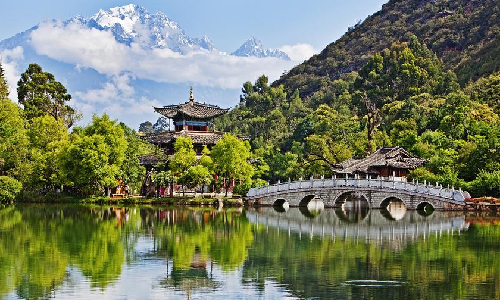
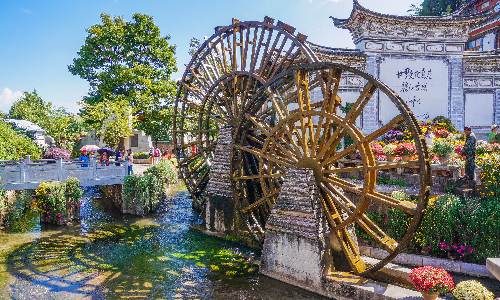
After breakfast, you will visit the Jade Dragon Snow Mountain. Consisting of 13 peaks, Jade Dragon Snow Mountain has a total length of about 75 kilometers. The main peak, named Shanzidou Peak, is at an altitude of 5,596 meters. It is covered by snow all year round, and the height of the snow line is between 4,800 and 5,000 meters.
Then you will go to Spruce Meadow by cable car. Located in the east of Jade Dragon Snow Mountain, Spruce Meadow is a large lawn that hides in the primeval spruce forest. It is at an altitude of 3,240 meters. You can see evergreen pines swinging in the wind and yaks eating grass at leisure here. What a beautiful pastoral scene! Spruce Meadow means a land of tragic love according to the language of Naxi nationality. It is said that Spruce Meadow is the place where the first couple of Naxi nationality died for love.
And then we will drive southeast for about 12 minutes to visit Blue Moon Valley, 7 kilometers away from Spruce Meadow. Blue Moon Valley is famous for its beautiful valleys and extremely blue lake. Blue Moon Valley got its name because of the blue lake and crescent-shaped valley here. And this Blue Moon Valley is said to be the prototype of the valley in the book The Lost Horizon written by British author James Hilton. On sunny days, the color of the lake is blue. On rainy days, the color of the lake is white because of white mud in the lake, thus Blue Moon Valley is also called White Water Lake. It is a wonderful place to take some nice pictures to post on your social media!
In the afternoon, you will go to Baisha Village. Baisha Village, at the foot of Jade Dragon Snow Mountain is well-known for Baisha Mural Paintings. This village is with a history of more than 1,000 years. Baisha Mural Paintings are important parts of the World Cultural Heritage in Lijiang. They cover a wide range of subjects, such as galloping horses, blooming lotus, lush mountains, colorful flowers, vivid animals, and interesting figures. And the figures depicted in the murals vividly show the life of that time, and have great artistic research value.
Then we will drive southward for about 10 minutes to Shuhe Ancient Town, which is 5 kilometers away from Baisha Village. Shuhe Ancient Town means a town at the foot of the mountain according to the language of Naxi nationality. It is one of the earliest settlements of ancestors of Naxi nationality in Lijiang. What’s more, Shuhe Ancient Town is a well-preserved town on the Ancient Tea Horse Route, a commercial route in southwest China in ancient times. The Sifang Street in the town was once a hub for fur trading, and is now a bustling area with various specialty shops and restaurants. It is a nice place to buy some souvenirs for your family and friends.

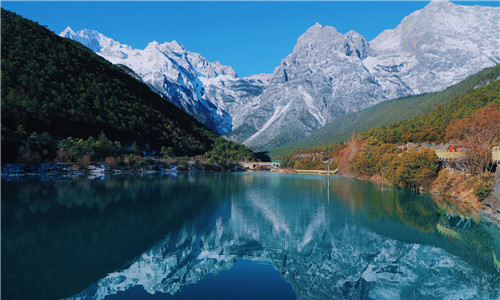
 Shangri-La
Shangri-La In the morning, we will drive northwest for around two hours and forty minutes to go to Shangri-La, about 173 kilometers away from Lijiang. Located in northwestern Yunnan Province, Shangri-La is a popular tourist destination. Occupying a total area of 11,613 square kilometers, it has a population of more than 186,412. It was first popularized in 1930s by the British writer James Hilton in his novel Lost Horizon. The novel presents a beautiful and halcyon Shangri-La where people in the world are eager to live in. It boasts splendid natural scenery and various attractions, such as Tiger Leaping Gorge, Ganden Sumtseling Monastery, and Potatso National Park. Shangri-La is certainly worth a visit!
In the afternoon, we will take you to your next stop, Tiger Leaping Gorge. Tiger Leaping Gorge, known for its steepness, is one of the deepest gorges in China. Mountains stand high on both sides of the gorge. Jade Dragon Snow Mountain is at its east and Haba Snow Mountain is at its west. The difference in height from the bottom of the valley to the mountain top beside it is more than 3,000 meters, making it about 1,500 meters deeper than the Grand Canyon of Colorado in the United States. Travelling here, you can wear outdoor jackets, hats, and anti-skid hiking boots. What is more, you can carry chocolate, compressed biscuits and other energy food just in case you get hungry during the hiking. After visiting the Tiger Leaping Gorge, you will be transferred to your comfortable hotel in Shangri-La for a good rest.
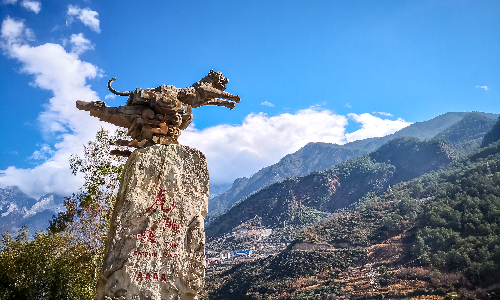

After breakfast, you will visit Ganden Sumtseling Monastery. Ganden Sumtseling Monastery is the largest Tibetan Buddhist temple in Yunnan Province. Built in the year of 1679 on the mountain, it looks like an ancient castle. It has a collection of Tibetan artworks, thus it is also known as the Tibetan Art Museum. There are many treasures of past dynasties in Ganden Sumtseling Monastery, such as eight golden Buddha statues of Sakyamuni (the founder of Buddhism), exquisite Thangka (a type of religious painting in Tibetan Buddhism), gold and silver censer (a container for burning incense during religious ceremonies). The main hall in the monastery is especially worth visiting, with colorful murals describing historical allusions of Buddhism. Located at an altitude of more than 3,300 meters, the temperature here varies greatly between day and night. Snow can be seen occasionally even in August, so it is strongly recommended that you bring warm clothes even in Summer. In addition to the changeable weather, ultraviolet radiation here is strong, so you’d better prepare sunscreen, sunhat and sunglasses.
In the afternoon, you will come to Potatso National Park for sightseeing. With Bita Lake, Shudu Lake and Militangya Alpine Ranch as the main parts, Potatso National Park is one of the main attractions in Shangri-La. Occupying a total area of 1,313 square kilometers, it has lakes, wetlands, forests, meadows, as well as rare plants and animals. The original ecological environment here is well preserved. The abundant rainfall and pleasant climate here make plants grow luxuriantly. As for rare animals, there are black-necked cranes, macaques, lynxes, clouded leopards, golden cats, black muntjacs and so on.
Then you will visit a Tibetan Family. Walking into a local town mainly inhabited by Tibetans, you will see Tibetans wearing their ethnic costumes. They are very hospitable to visitors. They might give you white Hada, a piece of silk used as a greeting gift, and serve you with local food, like highland barley wine, buttered tea as well as yak meat. They might also tell stories of their nationality when eating delicacies. Strolling around, you will see prayer flags swinging in the wind. The flags are printed with prayers to worship the gods, and the locals believe that the wind will blow the prayers to heaven. You may find that this is a place with the power to purify your soul and calm you mind.
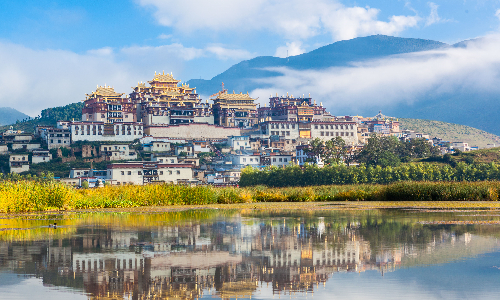

 La-Shanghai
La-Shanghai You have the whole morning to have a good rest in the hotel or stroll around in the vicinity. In the afternoon, our driver will transfer you to the airport. You will take the estimated flight MU7891 15:55/ 21:55 to Shanghai. Shanghai, an internationally famous city, is located in the east of China. As one of the largest seaports in the world, Shanghai has become an important center of finance, commerce, shipping, scientific, and technological innovation in China. Covering a total area of 6340.5 square kilometers, it has a population of more than 24 million. Shanghai attracts millions of tourists from home and abroad with its unique charm. It is a popular travel destination where you can visit Jade Buddha Temple, go for a stroll in the Yu Garden, enjoy local snacks in the Shanghai Old Street, and overlook the Bund from Oriental Pearl TV Tower.
Upon arrival, your local guide will wait for you in the airport and then you will be transferred to your comfortable hotel to have a good rest.
After breakfast, you will visit Jade Buddha Temple. As one of the top ten tourist attractions in Shanghai, Jade Buddha Temple gets its name from the jade Buddhas worshipped in the temple. Although located in the bustling area, it is quiet and slow-paced inside the temple. Jade Buddha Temple is often likened to a paradise in the downtown. Covering an area of more than 7,733 square meters, it is an accurate imitation of temples in the Song Dynasty (960-1279). Following the temple style of the Song Dynasty, the medial axis is lined with three halls, with the Grand Hall as the main one. In the center of the Grand Hall lies a statue of Shakyamuni, the founder of Buddhism. On its two sides are statues of Amitabha Buddha and Medicine Buddha. These three large Buddhas sit cross-legged on lotuses and have serene looks. Besides this main hall, the Jade Buddha Hall is somewhere you cannot miss. In Chinese culture, jade symbolizes predestined relationship, so many young people come here to pray for blessing for their love lives.
Then you can go for a stroll in the Yu Garden (closed each Monday). Yu Garden is a classical garden in Jiangnan area (regions south of the Yangtze River). Covering an area of more than 20,000 square meters, it was built by Pan Yunduan, Governor of Sichuan in the Ming Dynasty to make his parents enjoy their retired life in peace. In Chinese, Yu means peace, so the garden got its name. But it was a pity that his parents died before the completion of Yu Garden. Sansui Hall in the Yu Garden used to be the place for holding governmental celebrations and proclaiming imperial edicts, as well as a place for local gatherings of literati and gentry in the Qing Dynasty. Besides this hall, there are many other spots worth visiting, like the Huge Rockery and Exquisite Jade Rock.
Afterwards, you will come to Shanghai Old Street. Walking into Shanghai Old Street, you may feel that you have returned to the bustling market of Shanghai 100 years ago. Time-honored shops and souvenir shops can be seen everywhere on the street. Although tea is not produced in Shanghai, there are many time-honored tea shops and some teahouses. Teahouse is a good place to go where you can have a pot of tea and enjoy slow-paced lifestyle. Small steamed buns and glutinous rice balls are popular snacks here for visitors. The former is the most famous traditional dim-sum in Shanghai. The small steamed bun is famous for its thin wrapper and delicious stuffing. The glutinous rice ball originates from the Song Dynasty, with sweet stuffing and glutinous rice wrapper. If you are a foodie, do not miss these snacks.
In the afternoon, you will visit Oriental Pearl TV Tower, a 468-meter high TV tower. Built on October 1st, 1994, it is one of the landmark buildings of Shanghai integrating city sightseeing, catering, shopping, entertainment, exhibition and television broadcasting. Oriental Pearl TV Tower is one of the best places to take a bird’s eye view of Shanghai. Many tour groups will go to Shanghai Tower for sightseeing, but it will cost more going there. It is a better choice to visit Oriental Pearl TV Tower with less spending to enjoy the same beautiful scenery. The Oriental Pearl TV Tower also owns the highest revolving restaurant in Asia, which is 267-meter high. Dinner is not included in our program, but if you want to have dinner here, just tell us and we will arrange it for you. On every March 8th, Oriental Pearl TV Tower will be lighted in pink to call on the whole society to care for women. And it will be lighted up in blue to call attention to care for people with autism on every April 2nd.
After that, you will go to the Bund. The 1.5-kilometer long Bund is one of the attractions that you should not miss when travelling in Shanghai. It combines both modern and historical features of Chinese culture. Dozens of classical revival buildings of various styles, known as Exotic Building Cluster can be found here, attracting more and more tourists from home and abroad to experience Shanghai’s diversified culture.
Today’s trip is going to end now. Then you will be transferred to your comfortable hotel for a good rest.
Optional Activity:
If you want to enjoy beautiful night scenes in Shanghai, this 60-minute Huangpu River Night Cruise is a good choice. Sitting on the cruise ship, you will find that buildings on both sides of the Huangpu River are decorated by bright and colorful lights. Oriental Pearl TV Tower is shining in the night sky, and high-rise buildings at nighttime look even more charming than in the daytime. Taking this cruise ship, you can feel the cool breeze and enjoy splendid night scenes.
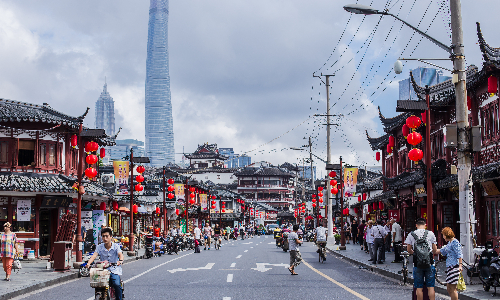
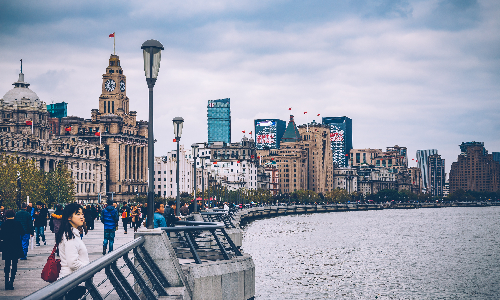
Your 16-day China Dreamland Budget Tour is going to end today. Your guide will take you to the airport according to your flight schedule and say goodbye to you. We are looking forward to serving you again in other cities of China.
Author: Gao Yamei
Proofreader: Li Yiwen
| City | Five Star hotel list | Four Star hotel list |
|---|---|---|
| Beijing | Sunworld Dynasty Hotel Beijing Wangfujing | Sunworld Hotel Wangfujing |
| Kunming | Grand Park Kunming | UChoice Hotel |
| Jianshui | Lin'an Hotel | Hanlinyuan Hotel |
| Yuanyang | Oness Resort Yuanyang Terrace | Oness Resort Yuanyang Terrace |
| Dali | The One Hotels & Resorts | Landscape Hotel |
| Lijiang | Wonderport International Hotel | Lijiang Wangfu Hotel |
| Shangri-La | Paradise Hotel | Ri Yue Xing Cheng Hotel |
| Shanghai | Ocean Hotel Shanghai | Courtyard by Marriott Shanghai Central |
 |
![]() About your child or infant, please contact us for a discounted price.
About your child or infant, please contact us for a discounted price.



We started with a few days in Beijing & ended in Shanghai, from where we visited the Forbidden City and Great Wall. In between we visited Terra Cotta Warriors Museum, Panda Base, Shanghai Disneyland.

We had a wonderful holiday in China which will remain long in the memory. China is a breathtakingly beautiful country full of splendid temples and palaces, mountains and rivers, peaceful rural scenes and bustling shopping streets.
 QUICK ENQUIRY
QUICK ENQUIRY